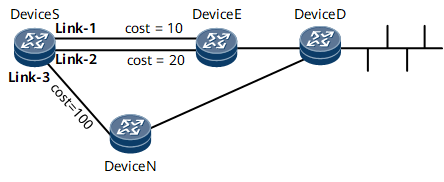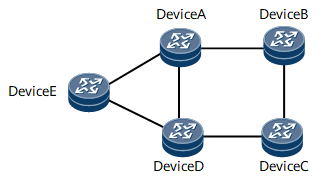Enabling OSPF IP FRR
With OSPF IP FRR and loop-free backup links, a device can switch traffic to a backup link immediately if the primary link fails.
Procedure
- Run system-view
The system view is displayed.
- Run ospf [ process-id | router-id router-id | vpn-instance vpn-instance-name ] *
An OSPF process is started, and the OSPF view is displayed.
- Run frr
The OSPF FRR view is displayed.
- Run loop-free-alternate
OSPF IP FRR is enabled, and a loop-free backup link is generated.

OSPF can generate a loop-free backup link only when the OSPF IP FRR traffic protection inequality is met. For detailed description of OSPF IP FRR, see HUAWEI NetEngine 8000 F Series Feature Description- OSPF IP FRR.
- (Optional) Run frr-policy route { route-policy route-policy-name | route-filter route-filter-name }
An OSPF IP FRR filtering policy is configured.
After the OSPF IP FRR filtering policy is configured, only the OSPF backup routes that match the filtering conditions of the policy can be added to the forwarding table.
- If you want to configure remote LFA OSPF IP FRR, perform the following steps:
- (Optional) Run tiebreaker { node-protecting | lowest-cost | ldp-sync hold-max-cost | srlg-disjoint } preference preference
The solution of selecting a backup path for OSPF IP FRR is set.
By default, the solution of selecting a backup path for OSPF IP FRR is node-protection path first. In some cases, the solution needs to be changed to smallest-cost path first because of data forwarding capacity or link cost consideration. In Figure 1, the primary path is Link-1 (Device S -> Device E -> Device D), and Link-2 and Link-3 (Device S -> Device N -> Device D) are backup path candidates. By default, Link-3 is selected as the backup path. To change the solution of selecting a backup path for OSPF IP FRR to smallest-cost path first, run the tiebreaker command. After the command is run, Link-2 is selected as the backup path.Figure 2 shows an inter-board scenario, where Link-1 (Device A -> Device D) is the primary path, and Link-2 (Device A -> Device E -> Device D) is the backup path. If Link-1 fails, Link-2 functions as the new primary path, and Link-3 (Device A->Device B->Device C->Device D) functions as the new backup path. If Link-1 goes Up again but the LDP session has not gone Up, OSPF enters the Hold-max-cost state. Consequently, the primary path is still Link-2, and the backup path is still Link-3. If the LDP session goes Up but ldp-sync hold-max-cost is not configured, OSPF exits from the Hold-max-cost state when the timer used to delay sending an LDP session Up message expires. In this case, OSPF switches the primary path back to Link-1. Because the upstream and downstream entries reside on different boards and the downstream entry has not been updated when downstream traffic arrives, packet loss occurs. To resolve the problem, configure ldp-sync hold-max-cost so that OSPF preferentially selects the path with the maximum cost set by LDP-IGP synchronization when OSPF is in the Hold-max-cost state. Then OSPF switches the backup path to Link-1 and delivers the backup forwarding entry in advance. When the timer used to delay sending an LDP session Up message expires, OSPF exits from the Hold-max-cost state and switches the primary path to Link-1. Because the downstream backup entry is available, no packet loss occurs. - Run commit
The configuration is committed.

